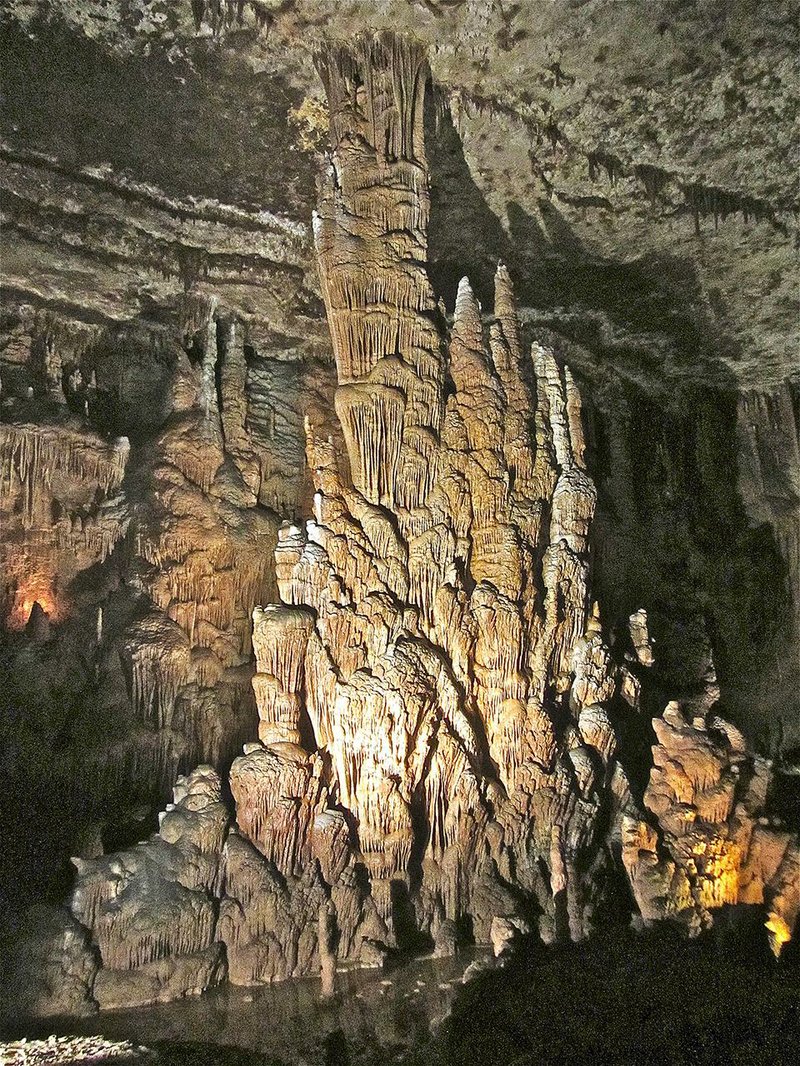BLANCHARD SPRINGS CAVERNS -- On the parking lot at Blanchard Springs Caverns, 230 feet overhead, the temperature on a sultry summer afternoon hovers in the mid-90s.
Down below, in the Cathedral Room of this spectacular Stone County cave complex, it's 58 degrees. It'll still be 58 degrees in December during the popular "Caroling in the Caverns" concerts. In this underground oasis, it's an identical 58 degrees every day of the year. Thanks to humidity near 100 percent, there's no real need for a jacket or sweater.
The two dozen visitors on the one-hour Dripstone Trail tour, the most accessible of the three Blanchard Springs itineraries, have descended by elevator. Then they've passed through an airlock designed to keep the cave as pristine as possible.
Accompanying them is a sprightly U.S. Forest Service guide named Jamela. She leads the way for nearly a half-mile on a paved path, mostly via ramps with railings, plus 50 stair steps. There are two rest areas with bleacher seating where she explains cavern features and answers questions.
Someone asks what would happen if an earthquake should strike during the tour. The caverns are far enough below the surface, she reassures the group, that even a strong quake would have little impact. A bit of nervous laughter ensues.
Jamela offers a refresher course in the difference between the vertical formations called stalactites ("they cling tightly to the ceiling") and stalagmites ("they're trying mightily to rise from the floor"). This is considered an "active" cave, she notes, which means that the landscape continues to change -- albeit ever so slowly.
There are 81 animal species in the caverns. The only mammals are five types of bats, whose population here is shrinking due to the same infection that is severely reducing their populations across the country.
Atop the underground food chain are salamanders, who consume insects and other smaller critters. The Ozark blind salamander, a native, was the first cave-dwelling amphibian found in the Western Hemisphere.
Cave details inspire comparisons with above-ground phenomena. The designer for the lighting in the caverns, according to Jamela, said the settings reminded him of opera houses.
She points out a flowstone formation on one wall that resembles the silhouette of a battleship -- or the ill-fated Titanic, as one visitor suggests.
The running water of Blanchard Springs continues to be the prime sculptor of the cavern. Since perhaps 300 million years ago, it has carved the galleries, while its dripping water deposits calcium carbonate and other minerals to slowly form the columns and other features.
As a complement to the guided tours, the Forest Service visitor center shows a 20-minute film, The Amazing World Below. Natural attractions above ground include the gushing springs along with Mirror Lake, which surges over a dam to create a photogenic waterfall. There are several hiking trails.
One feature of some other U.S. caves is missing from Blanchard Springs Caverns, namely the black-and-yellow Civil Defense signs from the Cold War years of the 1950s and '60s. These caves were almost recruited by the federal government as bomb shelters, but the plan was abandoned because of problems with air circulation.
For information on Blanchard Springs Caverns, located 15 miles northwest of Mountain View off Arkansas 15, call (870) 757-2211 or visit blanchardsprings.org. The caves are open daily from April to October, and closed on Monday and Tuesday in the off-season. Making tour reservations in advance is advised.
Fees for the one-hour Dripstone Trail and the more strenuous 11/2-hour Discovery Trail tours are $10 for adults, $5 for children ages 6-15, $5 for holders of the federal Golden Age Passport. The rigorous four-hour Wild Cave Tour, which involves climbing and crawling through muddy terrain, costs $75.
Eight privately owned commercial caves in northern Arkansas are open to the public for paid tours. Information can be found at arkansas.com.
Weekend on 07/30/2015
